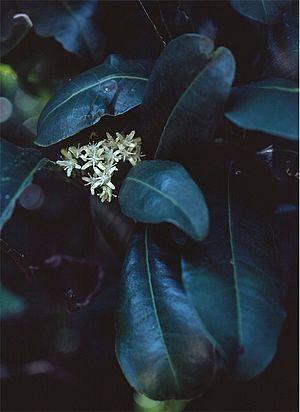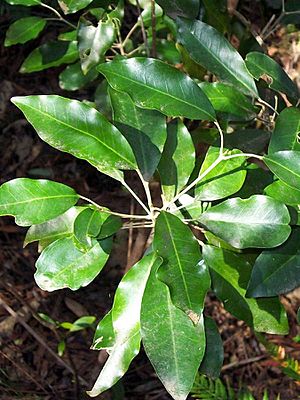Silver aspen facts for kids
Quick facts for kids Silver aspen |
|
|---|---|
 |
|
| Acronychia wilcoxiana in the Royal Botanic Garden, Sydney | |
| Scientific classification | |
| Genus: |
Acronychia
|
| Species: |
wilcoxiana
|
| Synonyms | |
|
|

The Acronychia wilcoxiana, often called silver aspen, is a special kind of small rainforest tree. It's found only in eastern Australia, which means it's endemic to that area. People also call it doughwood, snowwood, or mushyberry. This tree has simple, oval-shaped leaves that are narrower at the bottom. It grows groups of whitish flowers where the leaves meet the stem, and later it produces round, white fruits.
Contents
What the Silver Aspen Looks Like
The silver aspen is a tree that usually grows to be about 9–15 m (30–49 ft) tall. That's like a three-story building! It has bark that can be pinkish-brown or dark brown. The top part of the tree, called the crown, is full of dark green leaves.
Leaves and Flowers
The leaves grow in pairs, one across from the other. They are shaped like an oval or an egg, with the narrower part closer to the stem. Each leaf is about 70–210 mm (2.8–8.3 in) long and 25–90 mm (0.98–3.54 in) wide. They are attached to the branch by a small stalk called a petiole, which is 6–30 mm (0.24–1.18 in) long.
The flowers grow in groups that are fairly large, about 30–65 mm (1.2–2.6 in) long. You'll find these groups where the leaves join the stem, in an area called the leaf axil. Each individual flower sits on a tiny stalk called a pedicel, which is only 0.5–3 mm (0.020–0.118 in) long. Each flower has four small green parts called sepals, which are about 1.5–3 mm (0.059–0.118 in) wide. It also has four whitish petals, about 7.5–9 mm (0.30–0.35 in) long, and eight stamens (the parts that make pollen) that are different lengths.
Fruits and Seeds
The silver aspen usually flowers from January to May. After the flowers, the tree produces fruit. The fruit is a fleshy, cone-shaped or round fruit called a drupe. It's about 12–15 mm (0.47–0.59 in) long. Inside the fruit, you'll find black, oval-shaped seeds that are about 4.5 mm (0.18 in) long.
How the Silver Aspen Got Its Name
The silver aspen was first officially described in 1875 by a scientist named Ferdinand von Mueller. He first gave it the name Pleiococca wilcoxiana in his book Fragmenta phytographiae Australiae. Later, in 1974, another scientist named Thomas Hartley changed its name to Acronychia wilcoxiana. This new name was published in the Journal of the Arnold Arboretum. The species name, wilcoxiana, was chosen to honor James Fowler Wilcox. He was a person who collected birds and plants in northern New South Wales in the 1800s.
Where the Silver Aspen Grows
The silver aspen lives in rainforests. You can mostly find it between Fraser Island in south-east Queensland and Gosford in central-eastern New South Wales. It grows from sea level up to about 450 m (1,480 ft) high. There's also a small group of about eight grown trees that have been found in Primbee, in the Illawarra area.
Animals That Use the Silver Aspen
The fruits of the silver aspen are a tasty snack for rainforest birds. One bird that enjoys eating them is the wompoo fruit-dove.
Protecting the Silver Aspen
The Queensland Government has a list of plants and animals that need protection. The silver aspen is currently listed as being of "least concern" under their Nature Conservation Act 1992. This means that, for now, there are enough of these trees, and they are not considered to be in danger.
Growing Silver Aspen at Home
If you want to grow a silver aspen from its seeds, it can be a bit tricky. It's helpful to remove the fleshy outer layer, called the aril, from the seed first. This can help the seeds sprout better. Even with this step, the seeds might take a long time to grow, sometimes between 6 to 12 months!

